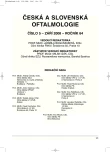Somatosensoric Prosthesis for the Blind
Authors:
O. Vyšata 1; A. Procházka 2; J. Kukal 2; P. Bečvárovský 3; L. Pazdera 1
Authors‘ workplace:
Centrum neurologické péče, Rychnov nad Kněžnou, vedoucí: MUDr. Oldřich Vyšata
1; Vysoká škola chemicko-technologická, Praha, Ústav počítačové a řídící techniky, vedoucí doc. Ing. Miloš Kmínek, CSc.
2; VMR s. r. o., Rychnov nad Kněžnou, vedoucí Ing. Petr Bečvárovský
3
Published in:
Čes. a slov. Oftal., 64, 2008, No. 5, p. 207-210
Overview
At present vision prosthesis proposes transmission of only a limited amount of visual information. Cutaneous receptor field may serve as a information channel. It has similar information-processing ability as retina. Lower information capacity of the skin may be compensated by wavelet transform image compression. Advances in microtechnology have facilitated the development of a haptic data visualization system with sufficient life-time for people with visual impairments. Proposed array with 2400 carbon electrodes stewed on elastic membrane in the present experiments demonstrate a good mechanical endurance, electrical stability and adhesivity to the trunk skin. Disadvantageous is short circuits production among near electrodes due to sweating and skin irritation after long term electrical stimulation. Vibrotactile piezo-electric stimulators are safer alternative with lower resolution. Comparing retinal and cortical vision prosthesis offers electrocutaneous communication system comparably higher amount of transmitted information.
Keywords:
vision prosthesis, somatosensoric analyzer, blindness, wavelet transform
Sources
1. Duci, A., Yezzi, A. J., Mitter, S. K. et al.: Region Matching with Missing Parts. in ECCV 3, 2002 : 48–64.
2. Fritz, J.P., Barner, K.E.: Design of a haptic data visualization system for people with visual impairments. IEEE Trans Rehabil Eng. 7, 1999; 3 : 372-84.
3. Gonzales, R. C., Woods, R. E., Eddins, S. L.: Digital Image Processing Using MATLAB, Prentice Hall, 2004.
4. Guleryuz, Onur G.: “Iterated Denoising for Image Recovery,” in Data Compression Conference (DCC ’02), Snao Bird, Utah. 2002, IEEE.
5. Haase, S.J., Kaczmarek, K.A.: Electrotactile perception of scatterplots on the fingertips and abdomen. Med Biol Eng Comput. 43, 2005; 2 : 283-9.
6. Hallum, L.E., Dagnelie, G., Suaning, G.J. et al.: Simulating auditory and visual sensorineural prostheses: a comparative review. J Neural Eng. 4, 2007; 1 : 58-71.
7. Humayun, M.S.: Intraocular retinal prosthesis. Trans Am Ophthalmol Soc. 2001; 99 : 271-300.
8. Javaheri, M., Hahn, D.S., Lakhanpal, R.R. et al.: Retinal prostheses for the blind. Ann Acad Med Singapore. 35, 2006; 3 : 137-44.
9. Kingsbury, N.: Complex Wavelets for Shift Invariant Analysis and Filtering of Signals. Journal of Applied and Computational Harmonic Analysis, 10, 2001; 3 : 234–253.
10. Li, S., Shawe-Taylor, J.: Comparison and Fusion of Multiresolution Features for Texture Classification. Pattern Recogn. Lett., vol. 25, 2004.
11. Loomis, J.M.: Counterexample to the hypothesis of functional similarity between tactile and visual pattern perception. Percept Psychophys. 54, 1993; 2 : 179-184.
12. Majji, A.B., Humayun, M.S., Weiland, J.D. et al.: Long-term histological and electrophysiological results of an inactive epiretinal electrode array implantation in dogs. Invest Ophthalmol Vis Sci. 40, 1999; 9 : 2073-81.
13. Newland D. E.: An Introduction to Random Vibrations, Spectral and Wavelet Analysis, Longman Scientific & Technical, Essex, U.K., third edition, 1994.
14. Pascual-Leone, A.,Torres, F.: Plasticity of the sensorimotor cortex representation of the reading finger in Braille readers. Brain. 116, 1993; 1 : 39-52.
15. Perez CA, Santibanez AJ, Holzmann CA et al.: Power requirements for vibrotactile piezo-electric and electromechanical transducers. Med Biol Eng Comput. 41, 2003; 6 : 718-726.
16. Rioul, O., Vetterli, M.: Wavelets and Signal Processing. IEEE SP Magazine, pp. 14–38, October 1991.
17. Sadato, N., Pascual-Leone, A., Grafman, J. et al.: Activation of the primary visual cortex by Braille reading in blind subjects. Nature. 380, 1996; 11 : 526-528.
18. Shim, J.W., Liu, W., Tang, H.: System development for multichannel electrotactile stimulation on the lips. Med Eng Phys. 28, 2006; 7 : 734-739.
19. Shinohara, M., Shimizu, Y., Mochizuki, A.: Three-dimensional tactile display for the blind. IEEE Trans Rehabil Eng. 6, 1998; 3 : 249-256.
20. Sommerhalder, J., Oueghlani, E., Bagnoud, M. et al.: Simulation of artificial vision: I. Eccentric reading of isolated words, and perceptual learning. Vision Res. 43, 2003; 3 : 269-283.
21. Tommerdahl, M., Favorov, O., Whitsel B.L.: Optical imaging of intrinsic signals in somatosensory cortex. Behav Brain Res. 135, 2002; 1-2 : 83-91.
22. Tang, H., Beebe, D.J.: A microfabricated electrostatic haptic display for persons with visual impairments. IEEE Trans Rehabil Eng. 6, 1998; 3 : 241-248.
23. Vaseghi, Saeed V.: Advanced Signal Processing and Digital Noise Reduction, Wiley & Teubner, West Sussex, U.K., 2000.
Labels
OphthalmologyArticle was published in
Czech and Slovak Ophthalmology

2008 Issue 5
Most read in this issue
- Benign Masquerade Syndromes in Differential Diagnosis of Uveitis
- Long Term Outcomes of Chronic Abducens Palsy Surgical Treatment in Children and Adults
- 3D Ultrasonography Diagnostics of the Eye and Orbit
- Ophthalmic Complications after the Embolization of the Internal Carotid Artery – a Case Report
